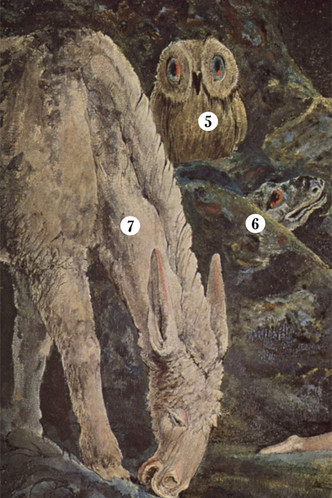Contents
What will the goddess Hecate choose — free passion or law? Life or immortality? Why did William Blake portray the powerful goddess as so lonely and lost? Our experts look at the painting and tell us what they know and feel.
The British poet and painter William Blake (1757–1827) painted Hekate in 1795. It is exhibited at the Tate Gallery in London. The Romans called Hecate «the goddess of the three roads», the omnipotent ruler of everything that happens in these directions. She was depicted in the form of three figures connected by their backs. Three of her heads confidently looked forward, each in its own direction.
In the painting by William Blake, Hecate is depicted in violation of the canon: the figures are separated from each other. Two are facing each other, and the third generally looks somewhere to the side.
1. Central figure
Maria Revyakina, art historian: “The mysticism of the work is emphasized by the gloomy color scheme, the bizarre play of lines and the violation of traditional perspective and composition. Only the main character seems to be a real entity, and everything else seems to live its own separate life in another world.
Andrey Rossokhin, psychoanalyst: “I see in this violation of the canon a clear rejection of power over space. Refusal (or inability?) to indicate direction.
2. Male hands and feet
Maria Revyakina: “Attention is drawn to the male hands and massive feet of Hekate: masculinity in this case acts as a symbol of strength and power. Behind the dreamy female appearance is hidden a huge power, which, apparently, frightens the heroine herself.
Andrey Rossokhin: “The main figure of Hekate resembles the Demon Vrubel — the same pose, the same bisexuality, a combination of male and female. But the Demon is extremely passionate, ready to move, and here I feel some kind of depression and enormous internal tension. There is no power in this figure, its power seems to be blocked.
3. Sight
Maria Revyakina: «Hecate’s gaze is turned inward, she is lonely and even frightened, but at the same time arrogant and selfish. She is clearly not satisfied with loneliness and the world around her, full of fear, but Hecate understands that she has her own mission to fulfill.
Andrey Rossokhin: «Hekate’s hand lies on the book (8), this is definitely the Bible, as if it states the law, morality. But at the same time, her face is turned away from the Bible in the opposite direction. Most likely, she is looking at a snake, which, like a tempting snake (6), wants to seduce her.
4. Figures behind the back
Maria Revyakina: “The figures behind are more like some kind of faceless and sexless creatures, the color of their hair contrasts with the hair color of the heroine, which is symbolic. Dark hair color was associated with the mind, mysticism, understanding of the cosmos, while light hair color was associated with practicality, earthiness and coldness. The clash of duality and trinity in this picture is not accidental. Thus, the artist shows us Hekate as a lonely, vulnerable entity in its inconsistency and unity at the same time.
Andrey Rossokhin: “The two nude figures that represent the other two hypostases of the goddess are conditional Adam and Eve. They would like to meet, to unite in passion, but they are separated by Hecate, who does not know what to do. They looked down, not daring to look at each other. Their hands are helplessly lowered or even removed behind their backs. The genitals are closed. And at the same time, Hecate herself, let me remind you, looks into the eyes of the tempter, and keeps her hand on the Bible. She seems to be paralyzed, unable to choose one or the other.”

5. Minor characters
Maria Revyakina: “On the left side of the picture we see an owl (5), which in ancient times was considered a symbol of wisdom, but later became a symbol of darkness and evil. The snake (6) is insidious and cunning, but at the same time it is wise, immortal, possesses knowledge. Both the owl and the snake are tense. Only the donkey (7), whose image is associated with the knowledge of fate, is calm. He seemed to resign himself, submitting to Hecate (from mythology, we know that Zeus gave Hecate power over fate). His peace contrasts with the general tension.»
Andrey Rossokhin: “There is an obvious conflict between body and spirit, passion and prohibition, paganism and Christianity. Hecate, a phallic woman with colossal omnipotence, here takes on human features, begins to be seduced by sexuality, but is not able to make a choice either in favor of her divine power or in favor of earthly joys. The owl’s eyes (5) have the same reddish sheen as the snake’s. The owl resembles a small child caught up in sexual fantasies, whose eyes are wide open with excitement. The dragon (9), which flies with its wings spread in the background, is like a superego watching. He watches over Hekate and is ready to devour her if she chooses to become a mortal woman. If she regains the power of the goddess, the dragon will humbly fly away.
The voice of the unconscious
Andrey Rossokhin: “I perceive the picture as Blake’s dream. And I perceive all the images as the voices of his unconscious. Blake revered the Bible, but at the same time sang about love, free from dogmas and prohibitions. He always lived with this conflict in his soul, and especially at the age when he painted the picture. Blake does not know how to find a balance, how to combine pagan strength, sexuality, freedom of feelings with Christian law and morality. And the picture reflects this conflict as much as possible.
Characteristically, the largest figure here is the donkey (7). It is always present in the pictures of the Nativity of Christ, next to the manger where Jesus lies, and therefore I perceive it as a Christian symbol. According to Blake, Christ had to harmonize the body and soul, give place to sexuality. And therefore in his birth I saw something resolving, joyful. But there is no such harmony in the picture. The resolution of the conflict did not happen either in the life of the artist, or later.










